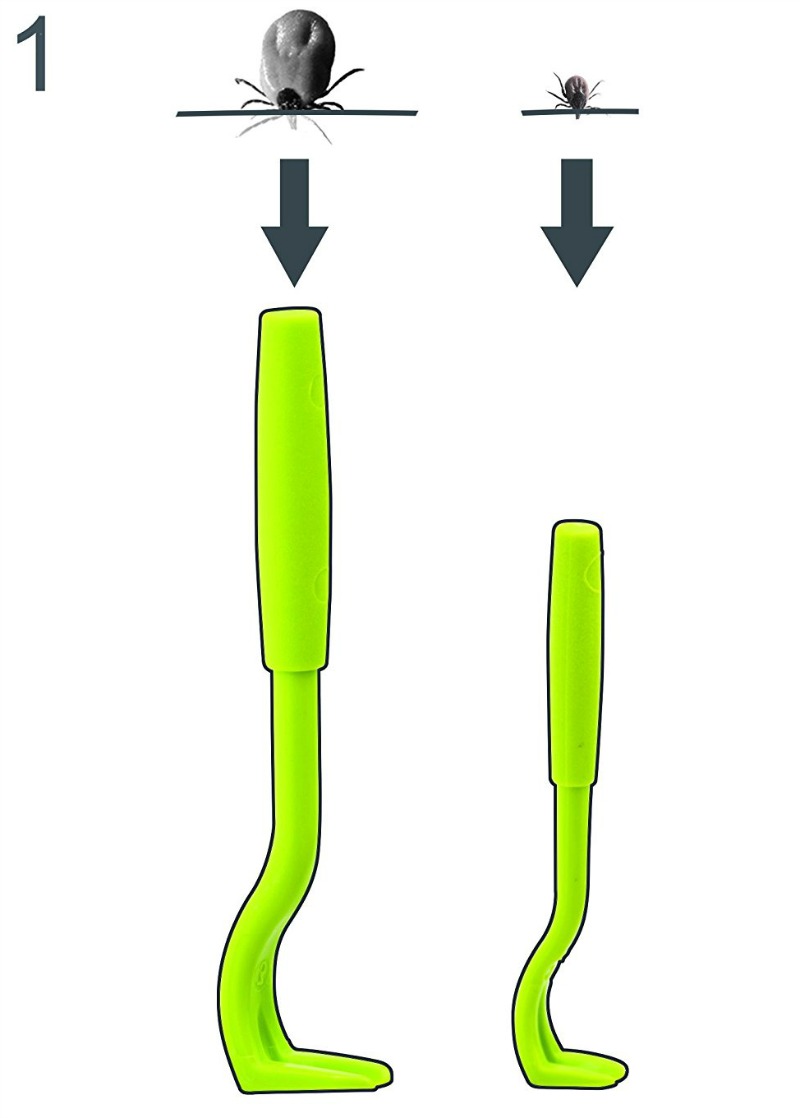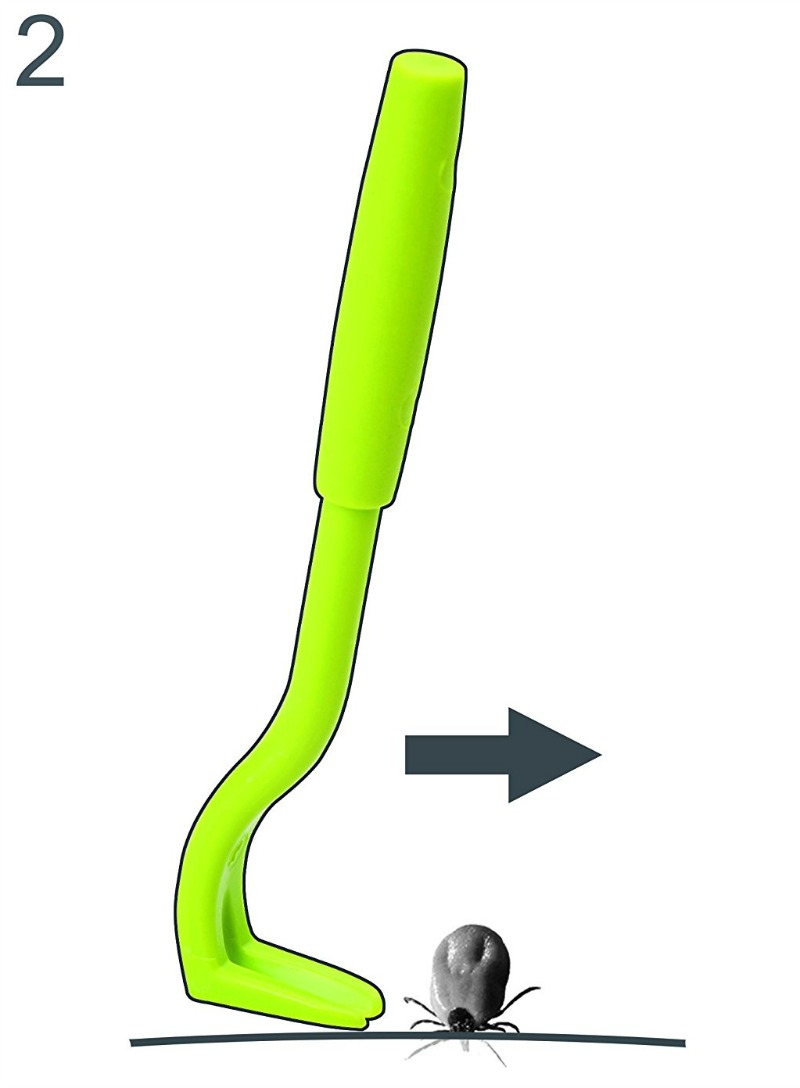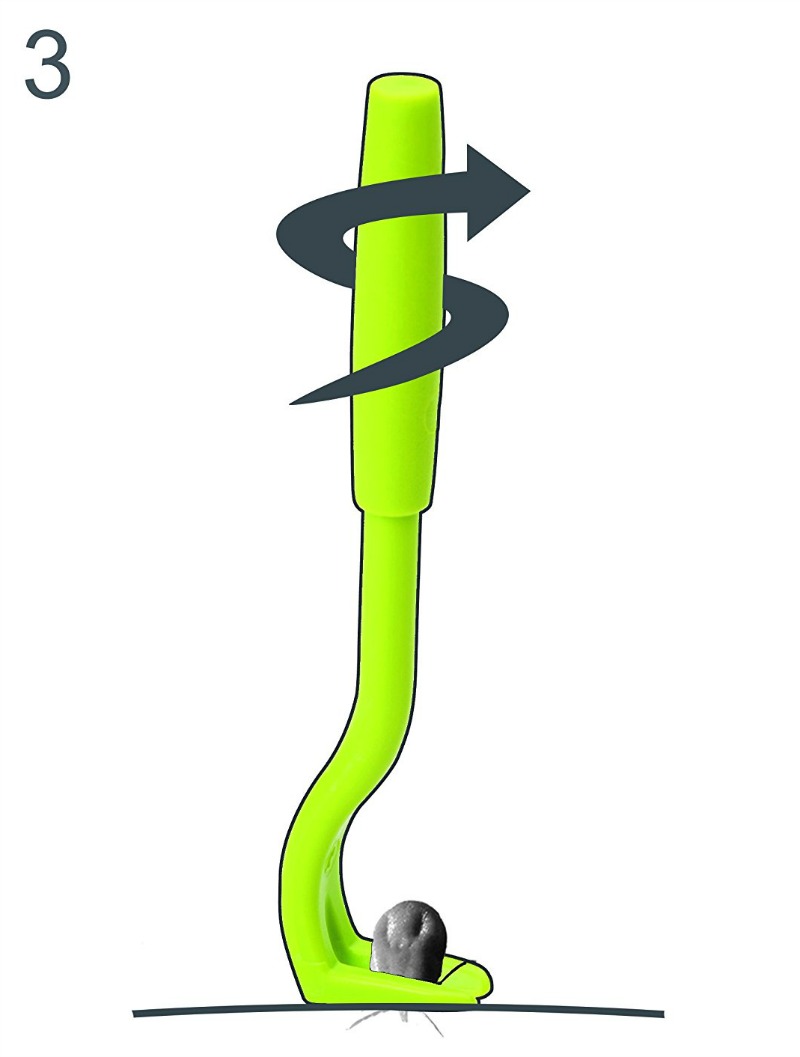Safe method to remove a tick without leaving the head stuck in the skin that works with small or large ticks and is easier than tweezers.

Each spring and summer, warmer weather and spending more time outside and camping outdoors increases the chances of exposure to nasty tick bites. The question is not “if” but “when” it will happen. And, when it inevitably does, how to remove a tick safely to minimize the chances of disease?
I have a friend who lives on a farm in Kentucky with his wife and five children. During tick season, he and his wife perform tick checks every night on all their children right before bathtime. They take ticks very seriously in their home because the Lyme disease carrying kind are very prevalent in their area.
It’s not just Lyme disease that is a potential risk either. The Journal of General Internal Medicine published an article by Susan Wolver, MD, and Diane Sun, MD, which identified a rising trend of red meat allergies from tick bites.
When one of my children was a fairly young baby and not even mobile yet, a tick lodged itself into the top of his head. Most likely, the tick dropped out of a tree onto his head, so don’t think your children are safe just because they aren’t hiking in the woods or walking in the grass!
If you discover that your child or pet has a tick that has lodged itself into the skin, here is the safest, easiest and quickest way to remove it.
How to Remove a Tick Safely and Quickly
The best way to remove ticks is using tweezers according to most authoritative sources. However, there is a new gadget called the tick twister remover that works even better.
My friend in Kentucky says that they used to use tweezers, but the tick twister is far superior and easier to use. It can be used to remove ticks from both pets and people.
Each tick twister tick removal set (it only costs about $6) has two removers inside: one large and one small. The different size is to allow for safe removal of both small and large ticks.
This ingenious device created by a veterinarian to safely remove ticks regardless of a person’s expertise has the following benefits:
- It is easier to use than tweezers especially for small ticks.
- It removes the tick without squeezing it, which greatly reduces the chances of disease transmission.
- It ensures the head and mouthparts of the tick are removed along with the body.
- It can be used for both large and small ticks.
Every home with children and/or pets should have one of these! It should also be included with camping equipment.
Safe Removal Steps. Better than Tweezers!
There are three steps for removing a tick using the tick twister.
First, you select which tick twister to use. If the tick is large, use the larger tick twister. If the tick is small, use the smaller one. Pretty simple!

Second, you grasp the tick between the head and body using the hook end of the tick twister. The picture below shows how to do it.

Third, simply twist the tick twister gently to easily and safely remove the entire tick out of the skin. That’s it!

After removing the tick, thoroughly clean the affected skin with alcohol. If there is any irritation, a dab of this herbal salve does wonders to quickly heal the skin.
Warning About some Tick Removal Recommendations
Some sources recommend pulling a tick straight out of the skin as the best method of removal.
This is very dangerous advice, because trying to pull a tick straight out will almost ALWAYS result in the head staying stuck in the skin. This is because ticks frequently lodge into the skin at an angle. They don’t usually burrow straight in perpendicular to the skin’s surface.
If you must use tweezers because you don’t have the tick twister remover available, be sure to pull the tick out at the same angle it went in.
This will give you the best shot at removing the head along with the body. In other words, grab the tick very firmly and close to the head as you can and pull out on a straight line but the same angle it burrowed in. I hope this makes sense.
It’s a little difficult to describe in words. This is the method taught to me by my Dad, who is a retired family doctor. Using this method, I’ve never left a tick’s head in the skin of any pet or person in over 40 years.
Of course, using the inexpensive tick twister is the best method of all. You don’t have to worry about angles – you simply twist the tick out of the skin!
How to Repel Ticks
This article describes the method for preparing an herbal yarrow tincture which is very effective at repelling ticks so you don’t have to remove them in the first place.
You ideally need to spray yourself every 2 hours or so.
Note that yarrow has been reputedly found by the US Army to be as effective as DEET in repelling ticks.








I had skimmed the original post at first, so I went back and read it thoroughly. Aside from the dangerous removal method described, there are other issues. A tick with a bright white spot on its back is a female Lone Star tick, which may be infective but probably not with Lyme. Male Lone Star ticks have no spot. Deer ticks have a dark “shield” above the head. It helps to look at tick identification images, which are numerous on the internet.
The term “tick fever” is archaic and vague. Deer ticks can carry Lyme disease and other TBDs. Each species carries one or more TBD. If you identify the tick that bit you, using the online photos, you can have an idea of what you may have been exposed to.
If you or a loved one has a tick bite, going right to the doctor for testing will not work. It takes a few weeks to build up a reaction, so immediate testing is completely useless, and since you will get a negative result, you may feel that you are safe from an infection, when you are not. I had a few tick bites, went to my family practice doctor, and got tested–and of course the results were negative. My doctor didn’t know that a waiting period is necessary.
The body part that may be left attached is usually the mouthparts, not the head. And of course, tweezers are very good at pulling out the whole tick, if they are fine-pointed and you pull slowly and smoothly. Even if mouthparts are left attached, they can not transmit disease, which is the important point.
These questions really are life and death issues. Misinformation about tick removal can kill or disable people. It is important to have the facts straight.
I am not Nancy, but I have come a looong way with integrative Lyme treatment. I did get Bicillin LA injections for 3 yrs. If I could get past the insomnia and fatigue I could live a normal life at this point, and if I can keep the Lyme at bay.
Many with Lyme disease know more than most drs., because we are left to discover what is going on with our bodies by ourselves. Thanks to Lyme communities for passing on info. It was an internet friend who was also misdiagnosed with MS that led me to getting my Lyme diagnosis.
None of my specialists diagnosed me with Lyme, I was even told I was in denial of my MS. Now that I have the Lyme diagnosis they all accept it. *rolling eyes*
*The smiley in my above post was supposed to be a frown.
Well, I’ve given up on doctors. The good ones on TBDs are out of my budget. The majority of doctors I’ve seen never even considered TBDs. One diagnosed me with intestinal candida, which I believe is true, but didn’t have the whole picture when it came to treatment. Most have made me worse so I consult my own sources of info before taking their advice. I will continue to explore alternative approaches. I just have to gather some energy to do that, which isn’t easy. I hope you do get past the insomnia and fatigue, and feel good again.
It’s tragic that the advice in the original post will make some people sick.
Judith, you may want to try echinacea/goldenseal combo. My young pastor was wheelchair bound when he was a teen and that is what his mother used to get him well. Here’s a good Lyme forum http://flash.lymenet.org/scripts/ultimatebb.cgi . I hope you find a treatment that works for you. Oh, you may want to try Prima Una de Gato (Cat’s Claw w/o pao (forget the letters)). My LLMD had me on that alone in the beginning, but I got another vector borne illness or reinfection of Lyme and had to go on abx. She still has me on CC. If you would like to email me my email is jpos123 @ Yahoo. com (spaces so it shows up in the post).
Jan, thanks for the recommendations! I have a lot to check out now. I was a member of the Lymestrategies Yahoo group, which discusses all sorts of alternative and conventional treatments. I should get back there. The brain fog is my worst symptom these days, and it’s so easy just to space it all out.
I know that Cat’s Claw is one of the herbs discussed at Lymestrategies. Time to research.
You are all overly kind and polite toward Sarah. How is it possible to be versed in Traditional Nutrition and be aware of the lacks, bias and pure ignorance of the medical community as per nutrition, and then hold local mainstream hospital opinion over that of those who are impacted by Lyme disease and well-versed in the literature? This stubborn unwillingness to look into something that is tearing into the world population and crippling and killing so many discredits Sarah and her work. SHAME ON YOU Sarah!!! Wake up!
Because her dad is an “old time country doctor.”
Twenty years ago I too tried matches and dish soap and all sorts of creative tick removal options recommended by old time country doctors and adventurous housewives. We didn’t worry much about ticks because they were as common as leaches and we didn’t know any better.
And I too thought the Lyme community was overreacting. I believed my old time country doctor. This trust led me to have an undiagnosed case of Lyme disease for 17 years. Then I learned about the controversy. Then I read every study I could get my hands on, and not just the ones in English. Then I educated myself. I know way more about Lyme and ticks than 99% of old country doctors, but that’s only because I had to learn if I wanted to get better. (And I did get better. So there.)
Give Sarah a break. She’s just parroting what she’s been told by people she trusts. And she’s unlikely to learn better unless someone she loves is affected personally. Aim your anger at the IDSA. They’re the ones putting forth policy, and they have their proverbial noggins up their nether regions.
Doctors can’t be specialized in all subjects, and country doctors have to be generalists. It’s only in the last decade or two that Lyme and TBD specialists have become more common and more knowledgeable. We can’t expect old-time doctors to know much about ticks, and the new discoveries about TBDs. That’s why some of us have posted expert information here.
IDSA have their noggins in their wallets, and the wallets of insurance companies. In order to protect profits, they are denying health care for people with chronic TBDs and causing disability and death. It’s despicable. So we need to educate ourselves.
Nancy, did you recover via conventional treatment, or something alternative?
Both.
I did about 18 months of antibiotics (oral doxycycline most of the time, amoxicillin in the summer) followed by 5 years of a modified Buhner protocol plus heat therapy. Every day for 5 years I drove my body temperature up to between 102F and 103F. This weakens the cell wall of the Bb bacteria and makes them more susceptible to antibiotics, or to herbal antibiotics.
I have to say, heat therapy was a real turning point for me. I started with a hot tub set at 105F. But now I just use a bathtub – I’m small enough to be completely immersed with just my nose above water. To heat more quickly, I shove a 10-gallon plastic container over my head and breathe the steam. (Do not try this alone, and do check with a doctor first. My PCP thought it was a great idea – my Lyme doctor was afraid I’d pass out and drown.)
I also gave up wheat – for that matter, all grains, and severely limited all forms of starch and sugar, including fruits and juices.
Nowadays I still have to do maintenance. I’ll take one dose of those herbal antibiotics daily, and I’ll still drive my temperature up once or twice weekly. I recently went off all maintenance for 6 months, since I’d had no symptoms for over a year. The Lyme came back in the form of migrating joint pain and swelling – first one ankle, then the other, then both wrists… along with mild cognitive impairment and sweats.
So I’m back on the Buhner herbs, and back to daily heat therapy. It’s already helping, and I expect to be back on easy peasy maintenance within a month. Over all I’m still doing well – just not as well as before I quit maintenance.
This too will pass. 🙂
Nancy, A friend recommended the Buhner herbs and I am going to find out about them. I bought a little portable plastic expanding FIR sauna, but the heat is not evenly distributed. I may try it again, though. I can fit in the tub fairly well, too, so that’s an option. Sounds like Buhner protocol and heat are your main, remaining strategies?
Very glad you have had such good results! I need to get back to doing something–have been sort of coasting lately. Glad to get such good feedback for the Buhner herbs.
Oops, sorry I commented on Judith being moderated. I didn’t see this until afterwards.
Seeing that Sarah responded to Judith’s post about moderation she must have read all our comments, but is not going to research and retract her advice. :o(
If I knew how to delete my post where I thought I was on moderation by Sarah, I would. If Sarah wants to delete it, that’s fine with me. I was mistaken. I did delete that post at Facebook.
Thank you for clarifying that. It was a natural conclusion, but I retract it now.
@Judith Please stop jumping to conclusions and accusing people of things that is untrue. I have placed no one on moderation. WordPress automatically puts any comments with multiple links in it into the review folder as it assumes it is spam.
I deleted my post from FB; don’t know how to delete it from the blog. Feel free to delete my post here about being on moderation.
If you google Dr. Joseph Burruscano, you will find the first hit to be a page at “lymediseaseresource.com”, click on that page and there is a link to download a PDF by Dr. Joseph Burruscano. Down at the bottom of the PDF he gives tips on how to remove ticks:
“HOW TO REMOVE AN ATTACHED TICK
Using a tweezer (not fingers!), grasp the tick as close to the skin as possible and pull straight out. Then apply an antiseptic. Do not try to irritate them with heat or chemicals, or grasp them by the body, as this may cause the tick to inject more germs into your skin. Tape the tick to a card and record the date and location of the bite. Remember, the sooner the tick is removed, the less likely an infection will result. “
Well, there is a lot of that in the area. Glad you were OK.
i have already had Rocky Mountain Spotted Tick Fever once about twenty five years ago….i had over three hundred bites when I contracted it…from the really small ones…they leave just as bad a welt.
Right on, William. Though it is safer to use fine-pointed tweezers or one of the new tick removal tools. You can expose yourself to a disease if you have even a microscopic cut in your finger, and some of the tick’s body fluids are released. But yes, they regurgitate in order to detach–in the process of dissolving the stuff that they cemented themselves in with. They have to secrete a cement to fix their mouthparts in the wound when they first attach, and have to puke gut contents up in order to get unattached. And those gut contents are likely to contain disease germs.